If you're new here, you may want to subscribe to my RSS feed. Thanks for visiting!
Pears are a late summer delight. Sweet, juicy, and easy to eat, they are ready in abundance right now. If you don’t have a pear tree of your own, be sure and stop by a local orchard or farmer’s market to enjoy the freshly picked fruit. (You can find a local orchard or market HERE.)
Pear trivia: Pears have been used as food since prehistoric times. They are one of the oldest cultivated fruits and were a valuable commodity along trade routes. Many different cultures documented recipes using pears. China is the largest grower of pears in the world, harvesting approximately 15.5 million tons of the sweet fruit. Pears are a member of the rose family.
Nutritional benefits
Pears are one of the most nutritious fruits around!
- One medium pear contains about 96 calories, no fat, 25 grams of carbohydrates, and more than 5 grams of fiber.
- Pears have extremely high levels of phytonutrients called flavonols, antioxidants that help prevent disease
- The skin of pears contain 3 times the level of phenols (an inflammation fighter) than the flesh of the pear
- Pears have been proven to lower the risk of Type 2 diabetes in women
- Because of their high fiber, pears can help improve body composition by keeping you full and satisfied for longer.
- Regular consumption of pears reduces the risk of many types of cancer, including colorectal, gastric, and esophageal cancers.
Using Fresh Pears
Most of the time, pears that you buy at the store or market will not be completely ripe. When selecting pears, look for very firm (but not hard) fruit. To speed ripening, store pears in a paper bag. To slow ripening, store them in the refrigerator.
Ripe pears bruise easily and should be carefully wrapped if you are sending them in a lunch box.
Pearsicles
A great way to use overripe pears is to make pearsicles.
It couldn’t be easier – puree pears in the blender with a small amount of lemon or lime juice. Pour them into your homemade popsicle forms.
If you have an abundance of pears, try this delicious recipe: Yogurt Cake with Brown Sugar Pears.
Pears are a delicious addition to a salad with a fruity vinaigrette and goat cheese.
Preserving Pears
Freezing
When freezing pears, you should peel them first. Freeze them in liquid (either white grape juice or a light syrup) in a freezer bag. Freezing them in liquid helps to prevent freezer burn. Another method is to slice the pears, toss them in lemon juice, then stir them into a cup of granulated sugar before placing them into a freezer bag.
Drying
Dried pears are a delicious treat. Peel the pears, then cut them into 1/8 inch thick slices. Place in a single layer on the rack of the dehydrater and dry on low for approximately 20 hours.
Canning
Try these delicious canning recipes for your bounty of pears…
Pear Slices
To can sliced pears, make a light syrup by adding 2 cups of sugar (I recommend organic turbinado) to 6 cups of water and bring it to a boil. You can also make the syrup with brown sugar for a richer flavor (I recommend organic muscavado.)
Place pears in the jars and top each jar with a teaspoon of lime juice (lemon works as well.) Whichever sugar you opt for, ladle the syrup over the pear slices, then process sanitized quart jars in a water bath canner for 35 minutes, adjusting for altitude. Alternatively, process them in a pressure canner at 5 pounds for 10 minutes, also adjusting for altitude. Approximately 3-4 medium pears fit snugly into a quart jar.
Pearsauce
Another great way to use an abundance of pears is to make pearsauce. Slightly sweeter than applesauce, it can be used in baking or substituted in any recipe that you would normally use applesauce.
I like to leave the skins on my pears since so many of the nutrients lurk there.
- Wash the pears carefully using a baking soda bath. If the pears are not organic, this will help to remove the pesticides in the event they have been sprayed.
- Remove the cores and any dark spots.
- Using a blender or food processer, puree the pears on a high setting.
- Pour them into sanitized jars.
- Process in a water bath canner for 20 minutes, adjusting for altitude.
Note: Pear sauce sometimes separates during the canning process. Don’t be alarmed – it won’t affect the quality or the taste. Simply shake the jar well before serving.
Merlot Spiced Pears
This is the be-all and end-all canned pear recipe. Not only does it taste decadent, but the way your house smells when you make it will bring everyone to the kitchen just to inhale it.
Ingredients
- 2 bottles of merlot or other red wine (opt for a drier red than you would usually drink)
- 2 cups of turbinado (or white) sugar
- 1 cup of water
- 2 tablespoons of cinnamon powder
- 1 teaspoon of clove powder
Directions
- Pour the wine and water into a saucepan and bring it to a simmer on low heat.
- Meanwhile, mix the spices and sugar in a bowl until well combined.
- When the wine mixture is simmering, stir in the sugar mixture. Stir with a whisk until the sugar and spices are dissolved in the wine.
- Simmer on low heat for 15 minutes.
- While the wine syrup is simmering, pack sliced pears into 6 sanitized quart jars.
- Ladle the hot wine syrup over the pears, leaving 1/2 inch of headspace.
- Process in a water bath canner for 20 minutes, adjusting for altitude.
Do you have even more pears to put up? Check out this canning recipe for Vanilla Spiced Pears…

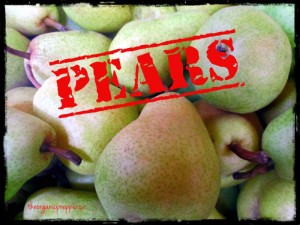
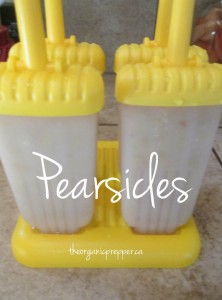
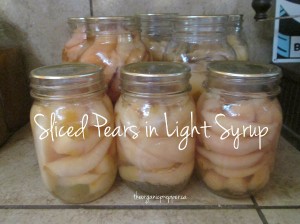
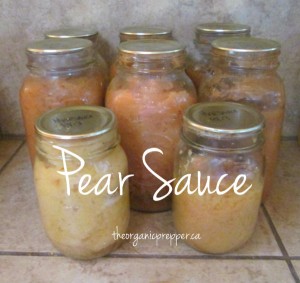
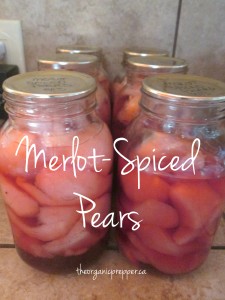














Thanks for all the great recipes. The merlot pears look amazing! What type of pears do you use? We have a pear tree on our property that produces zillions of small, hard pears. I’ve heard older folks around here call them “knobby pears.” Lol! They have a thick skin, & I wonder how they would turn out…
Hi, M!
The pears I got are Bartletts. 🙂 I generally peel pears for canning and if they have that thick skin I think it is definitely a good idea. 🙂
~ Daisy
I absolutely adore pears. They’re definitely up there on the list of my favourite fruits. Those merlot spiced pairs you made look sooo good. Should give them a shot.